 |
| João
A. N. Batista Universidade Federal de Minas Gerais Depto. Botânica Av. Antônio Carlos 6627 Pampulha C.P. 486 Belo Horizonte, MG 31270-910 Brasil. janb@icb.ufmg.br |
Luciano de Bem Bianchetti Embrapa Recursos Genéticos e Biotecnologia Parque Estação Biológica Final Av. W5 Norte C.P. 02372 Brasília, DF 70770-901 Brasil. bianchet@cenargen.embrapa.br |
|
Originally published in Novon, journal for botanical nomenclature from the Missouri Botanical Garden, volume 16, pages 17 to 22, on 25 May 2006 ABSTRACT. Cyrtopodium macedoi, a new species (Orchidaceae, Cymbidieae, Cyrtopodiinae) from the cerrado vegetation of central Brazil, is described and illustrated. The species was first collected in 1951, but was subsequently misidentified as C. vernuum . The principal distinctive character for C. macedoi is the basal portion of the corolla lip and the region between the lateral lobes, which is strongly deflexed and almost parallel to the lip midlobe. Cyrtopodium macedoi appears to be rare and so far known only from two sites in the Triângulo Mineiro region of the western part of the state of Minas Gerais in southeastern Brazil. Key words: Orchidaceae, Cymbidieae, Cyrtopodiinae, Cyrtopodium, cerrado, Brazil. Cyrtopodium,
a Neotropical genus that ranges from southern Florida
to northern Argentina, contains about 45 species,
36 of which occur in Brazil. The center of diversity
of the genus is the Brazilian cerrado vegetation,
where about 28 species occur. The cerrado is a species-rich
savanna vegetation covering 2 million km2 of central
Brazil (Ratter et al. 1997). A particularly Cyrtopodium-rich
area is the “Distrito Federal” or Federal
District, located in the cerrado core region, where
18 taxa are known (Batista & Bianchetti, 2003). |
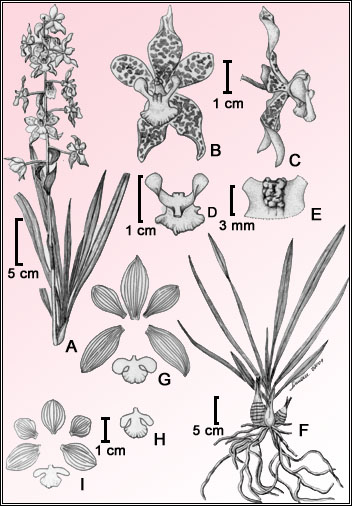 |
Figure
1. Cyrtopodium macedoi J.A.N. Batista & Bianchetti A. Inflorescence and leaves at anthesis B. Flower, front view C. Flower, side view D. Lip, back view E. Callus F. Habit, about 1-2 months after the flowering period G. Perianth H. Variation in lip morphology I. Variation in perianth. Drawn from the type collection, Batista & Bianchetti 1306, except H and I (Macedo 3385) by Simone C. Souza e Silva. |
|
Cyrtopodium
macedoi J.
A. N. Batista & Bianchetti
Novon vol 16/17:22, 2006. TYPE: Brazil. Minas Gerais: flowered in cultivation in Brasília from Sep. to early Oct. 2003, J.A.N. Batista & L.B. Bianchetti 1306 (holotype, CEN; isotypes: K, MO, SP). Figures 1-9. Cyrtopodium
macedoi partibus vegetativis C. caiapoensi L.C.
Menezes simile, morphologia florali C. poecilo Reichenbach.f.
& Warming simile et florum colore C. pallido
Reichenbach.f. & Warming simile, sed a his et
ab omnibus speciebus generis basi labelli et parte
intra lobos laterales fortiter deflexa, fere parallele
ad basim lobi centralis disposita et calo erecto,
integro, paulo vel non verrucoso, omnino disposito
in basi lobi centralis labeli differt.
Terrestrial herb; pseudobulbs completely buried
to partially exposed, small, oblong, apex acute,
leafless from the second year onward, externally
whitened, 6-11 x 0.8-2.3 cm; roots numerous, 3.5-4
mm wide, glabrous. Leaves at flowering 6 to 9, partially
to well developed, (13)20-41 x (0.5)0.7-1(1.4) cm,
base with 4 or 5 sheaths, when fully developed 9
to 12, erect, coriaceous, linear to linear-lanceolate,
the more developed 37-68 x 1-1.9 cm, articulate,
the articulation 2.5-4 cm from the apex of the pseudobulb,
apex acuminate. Inflorescence lateral, erect, simple
to branched, 24-37 cm long, ca. 0.5 cm diameter,
green; peduncle 11-22 cm, with 2 sheath-like bracts,
adpressed, 1.7-3.6 x 1-1.3 cm, straw colored; rachis
12-14 cm long; lateral branches none to 2, short,
4-5.5 cm long; floral bracts well developed, broadly
lanceolate, deflexed, ca. same size or little longer
than the pedicellate ovary, 19-28 x 9-12 mm, apex
acute, margins slightly undulate, green with brownish-purple
spots; ovary with pedicel 16-23 mm long, perpendicular
to the rachis, green to greenish-brown. Flowers
ca. 15, slightly sweet-scented; sepals and petals
outspread, concave, margins smooth, toward the apex
undulate, apex minutely apiculate, green with brown
or brownish-purple spots; sepals broadly lanceolate
to broadly elliptical; dorsal sepal 14-27 x 9-11.5
mm; lateral sepals slightly oblique, 14-26 x 9-11
mm; petals obovate to almost orbicular, base cuneate,
apex obtuse to rotundate, 10-19 x 9-10 mm; lip 3-lobed,
9.5-12 mm long, when spread 14-19 mm wide between
the apex of the side lobes; base shortly unguiculate,
ca. 2 mm long, white; base and region between the
lateral lobes strongly deflexed, almost parallel
to the central lobe base; lateral lobes erect, inner
surface bent ca. 45o frontward toward the apex,
obovate-oblong falcate to linear falcate, 6-8 x
2.5-5 mm, apex rounded, base slightly to evidently
constricted, margins entire, smooth, pinkish; callus
entire, little to no verrucosities, then smooth,
protruding, erect, completely placed at the base
of the midlobe, not expanded between the lateral
lobes, upper surface slightly sulcate, whitened;
isthmus separating the lateral lobes from the midlobe
evident; midlobe with a 1-3 mm long base, somewhat
reniform to transversely elliptic, 6-8 x 9-12 mm,
base constricted, apex retuse when flattened, lateral
margins revolute, smooth, whitened with a few pink
dots at the center and a broad pinkish strip at
the margin; column erect, arcuate, trigonous, 6-8
mm long, 3.5-4 mm wide at apex, apiculate, base
whitened, at middle white-lilac and toward the apex
green to greenish-purple; column foot 4-5 mm long;
anther 2.5-3 x 1.5-1.8 mm, yellow, apex green; pollinia
two, waxy, sulcate, each ca. 1 mm long and 0.9 mm
wide, yellow; stipe triangular, hyaline, ca. 1.3
mm wide at base. Fruit not examined.
Etymology.
The new species is named in honor of Amaro
Macedo who first collected the species in 1951 and
whose intensive collecting in the Triângulo
Mineiro region has contributed greatly to our knowledge
of the flora of this region.
Distribution. Cyrtopodium macedoi is so far known only from two sites in the Triângulo Mineiro region in the western part of the state of Minas Gerais in southeastern Brazil. Little is left of the original native vegetation in the area. However, because of the existence of other regions with a similar vegetation and climate in the cerrado biome of central Brazil, this species should also be expected at other localities, most probably in the cerrado core region. According to the current knowledge of the species and using the World Conservation Union Red List Categories and Criteria (IUCN, 2001), C. macedoi can tentatively be classified as endangered. Habitat, Ecology and Phenology. Cyrtopodium macedoi appears to be typical of dry habitats and was found growing in dry campo limpo (grassy field) and campo sujo (dry grass-herb-sub shrub field) vegetation. Plants were found growing on deep clay latosols as well as shallow, rocky soil on hill sides. In the former case, the plants were vegetatively more developed and had pseudobulbs that were completely buried (Fig. 2). Cyrtopodium poecilum Rchb.f. & Warm., C. cristatum Lindl., C. brandonianum Barb. Rodr. and C. caiapoense L.C. Menezes are sympatric species found in similar habitats. Like most Cyrtopodium species in central Brazil, C. macedoi flowers during the beginning of the rainy season in October, but probably also extends into late September and early November. As with other terrestrial species of the genus, flowering in C. macedoi is greatly enhanced by fire (Oliveira et al. 1996). In 2002 and 2003, not a single flowering plant was found during field excursions to the two sites where the species is known to occur. However, plants collected from the same sites in 2002 and kept under cultivation flowered profusely when submitted to a controlled fire in 2003 (five out of seven plants flowered after they were burned). In the label from the collection Macedo 3385, there is no mention of fire, but the ends of the leaves are dry and partially missing, suggesting that they may have been affected by fire at an early stage of development. Cyrtopodium macedoi was first collected by Amaro Macedo in 1951, and it was through this single collection that we became aware of this species’ existence. The first excursion to the original site of collection revealed several plants, but none in flower. Only after some specimens kept under cultivation at Embrapa Recursos Genéticos e Biotecnologia in Brasília had flowered and after a detailed examination of the fresh flowers was it possible to positively recognize this taxon as a new species. The collection made by Amaro Macedo (Macedo 3385) was examined by the late orchidologist F.C. Hoehne, who mistakenly identified the species as C. vernuum Rchb.f. & Warm. Marcela I. Sánchez, who examined a duplicate of the Amaro Macedo collection located at the United States National Herbarium (US), identified it as C. vernuum var. ligulatum. However, as far as we could determine, this variety was never published. Furthermore, C. macedoi is certainly not a variety of C. vernuum and according to the International Code of Botanical Nomenclature (Greuter et al. 2000) in no case does a name have priority outside the rank in which it was published (art. 11.2). A very distinctive character of C. macedoi, not found in any other species in the genus, is the base and the part between the lateral lobes of the corolla lip, which is strongly deflexed and almost parallel to the lip midlobe (Fig. 7). Also, the callus of C. macedoi is uncommon in the genus since it shows little or no verrucosities, is protruding and is completely placed at the base of the lip midlobe (Figs. 7 and 8), whereas in most other species it is usually strongly verrucose, spread between the lateral lobes and frequently reaches the claw. Compared to other species in the genus, C. macedoi is similar to and can be easily confused in vegetative characters to C. caiapoense L.C. Menezes. However, Cyrtopodium caiapoense has brownish sepals and petals with strongly undulated margins, a shorter and less evident isthmus separating the lip lateral lobes from the midlobe, and non-falcate lateral lobes of the corolla lip. In flower morphology and color, C. macedoi is similar to C. poecilum Rchb.f. & Warm., particularly to C. poecilum var. roseum J.A.N. Batista & Bianchetti, that has a pink lip. However, C. poecilum has externally reddish-purple pseudobulbs (compare with fig. 3), fewer [5 or 6(7)] and broader (0.8-5.5 cm) leaves, parallel lateral lobes of the lip, a larger callus that is deeply sulcate and extends until the base of the lip (compare with figs. 4-6). Cyrtopodium macedoi is also similar in the morphology and color of the flowers to C. fowliei L.C. Menezes, but the latter species is from seasonally humid places, from southeastern Brazil to Venezuela, has smaller pseudobulbs (3-5 x 1-2.5 cm) that are externally reddish-purple, fewer (4-6) leaves, and shorter [4-5(6) x (4)5-6(7) mm], parallel and non-falcate lateral lobes of the lip. In the general color of the flowers, C. macedoi is similar to C. pallidum Rchb.f. & Warm., but the latter species is typically from dark, sandy-clay soil found in wetter areas, has smaller pseudobulbs (2.5-3.5 X 0.8-1 cm), fewer (4-6) leaves, an invariably simple inflorescence and smaller flowers (sepals (8)10-11(13) X 6-8(11) mm). Finally, C. vernuum , with which C. macedoi was previously confused, has larger (7-18 x 1.5-4 cm) and typically exposed pseudobulbs, a more branched inflorescence with (0)2-3(4) lateral branches (5)8.5-20(22) cm long, flowers that are yellow with red dots at the margins of the petals and sepals, and oblong, non-falcate lateral lobes of the lip. In older flowers of C. macedoi, the column bends down or the lip moves up so that the pollinarium at the column apex touches and rests over the callus, fitting exactly into the depression in the center of the callus (Fig. 9). In 24 years of collecting and examining hundreds of living specimens and flowers of several species, we have not seen anything similar to this arrangement in any other species of the genus. The significance of this organization is unknown. Paratypes.
BRAZIL. Minas Gerais: A. Macedo 3385 (SP, US); J.A.N.
Batista, K.F. Pellizzaro, M.C.D. Macedo & J.B.
Santos 1441 (CEN, K, MO, SP).
Acknowledgments.
The authors thank Amaro Macedo and his daughter,
Maria do Carmo D. Macedo, for logistical support
and for their assistance during our excursions to
the Triângulo Mineiro region. We also thank
the curator of SP for loans, Simone C. Souza e Silva
for preparing the illustration, Tarciso Filgueiras
for the Latin diagnoses, Stephen Hyslop for reviewing
the English, Victoria Hollowell and three anonymous
reviewers for improvements in the manuscript.
Literature Cited Batista,
J. A. N. & L. B. Bianchetti. 2003. Lista atualizada
das Orchidaceae do Distrito Federal, Brasil. Acta
Bot. Bras. 17(2): 183-201.
Cogniaux,
A. 1898-1902. Orchidaceae II. Cyrtopodium.
Pp. 356-375 in C.F.P. Martius, A.G. Eichler &
I. Urban (editors), Flora Brasiliensis, Vol. 3,
Part 5. R. Oldenbourg, Munich.
Greuter, W., J. McNeill, F. R. Barrie, H. M. Burdet, V. Demoulin, T. S. Filgueiras, D. H. Nicolson, P. C. Silva, J. E. Skog, P. Trehane, N. J. Turland & D. L. Hawksworth (Eds.) 2000. International Code of Botanical Nomenclature (Saint Louis Code) Regnum Veg. v. 138. Koeltz Scientific Books, Königstein. Hoehne, F. C. 1942. Orchidaceas. Cyrtopodium. Pp. 8-35, tab. 4-23 in F.C. Hoehne (editor), Flora Brasilica, Vol. 12, Part 6. Secretaria da Agricultura, Indústria e Comércio de São Paulo, São Paulo. IUCN, 2001. IUCN Red List Categories and Criteria. Version 3.1. Prepared by the IUCN Species Survival Commission. IUCN, Gland, Switzerland. Menezes, L. C. 2000. Genus Cyrtopodium: espécies brasileiras. Ed. IBAMA, Brasília. Oliveira R. S., J. A. N. Batista, C. E. B. Proença & L. B. Bianchetti. 1996. Influência do fogo na floração de espécies de Orchidaceae em cerrado. Pp. 61-67 in Anais do Simpósio Impacto das Queimadas sobre os Ecossistemas e Mudanças Globais. 3o Congresso de Ecologia do Brasil, Brasília-DF. Ratter, J. A., J. F. Ribeiro & S. Bridgewater. 1997. The Brazilian cerrado vegetation and threats to its biodiversity. Ann. Bot. 80: 223-230. Warming, E. 1884. Symbolae ad floram Brasiliae centralis cognoscendam. Part. 30. Orchideae 2. Videnskabelige Meddelelser fra den naturhistoriske Forening i Kjöbenhavn 5-8: 86-99. |
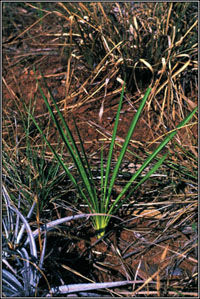 |
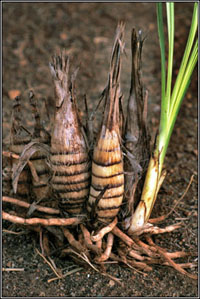 |
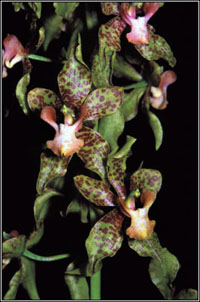 |
Figure
2 Cyrtopodium macedoi. Habit, non-flowering plant in its habitat about the time of flowering, in late October. |
Figure
3 Pseudobulbs, from an uprooted plant. |
Figure
4 Inflorescence. |
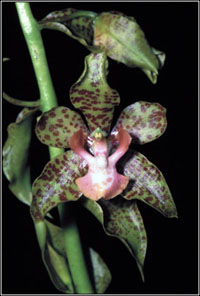 |
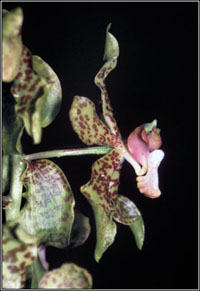 |
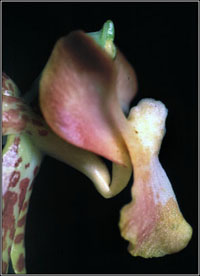 |
Figure
5 Flower, front view. |
Figure
6 Flower, side view |
Figure
7 Lip, side view. Note the strongly deflexed base of the lip. |
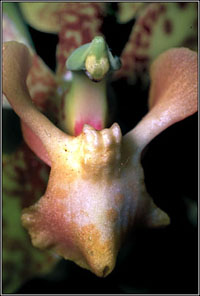 |
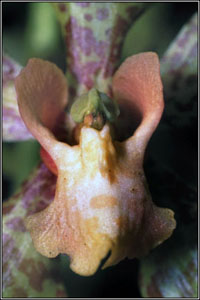 |
|
Figure
8 Lip and column, front view. |
Figure
9 Lip and column in old flower, front view. Note that the anther touches and rests over the callus. |
Photos: by the authors
| Any
kind of reproduction (print, digital or anyone) of any type of material
of this site: texts, layout, photos, images and others - is strictly forbidden without previous written permission of the authors. All rights reserved. Any solicitation or information by the e-mai:l bo@sergioaraujo.com |